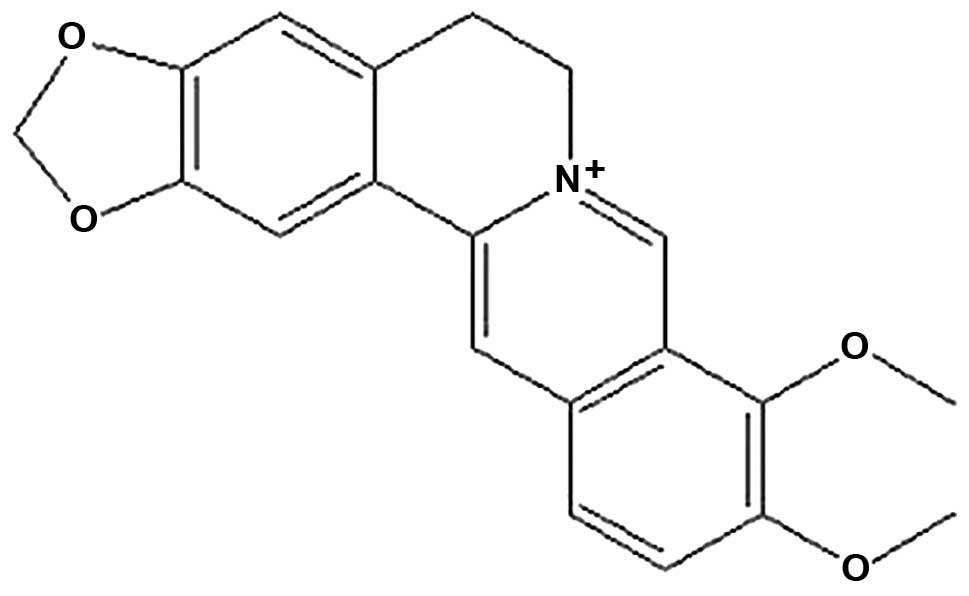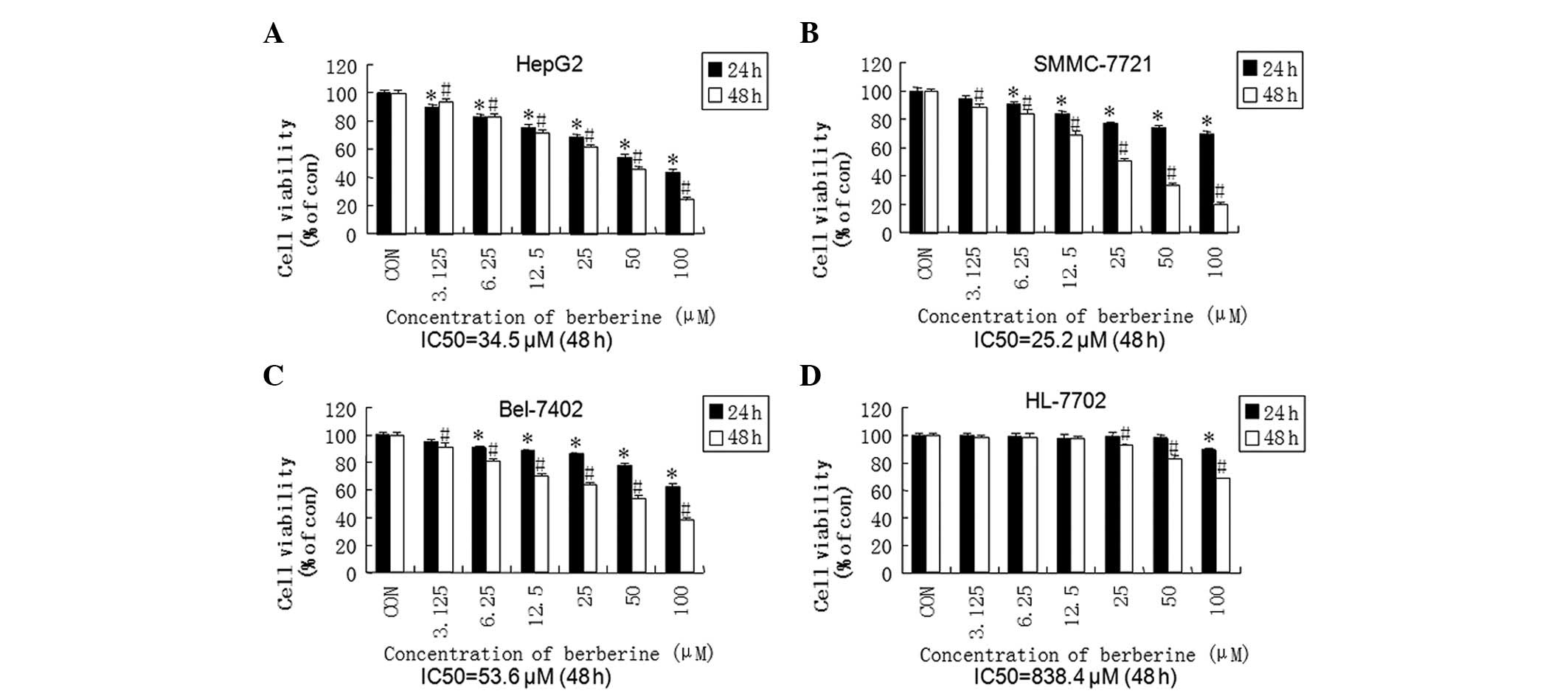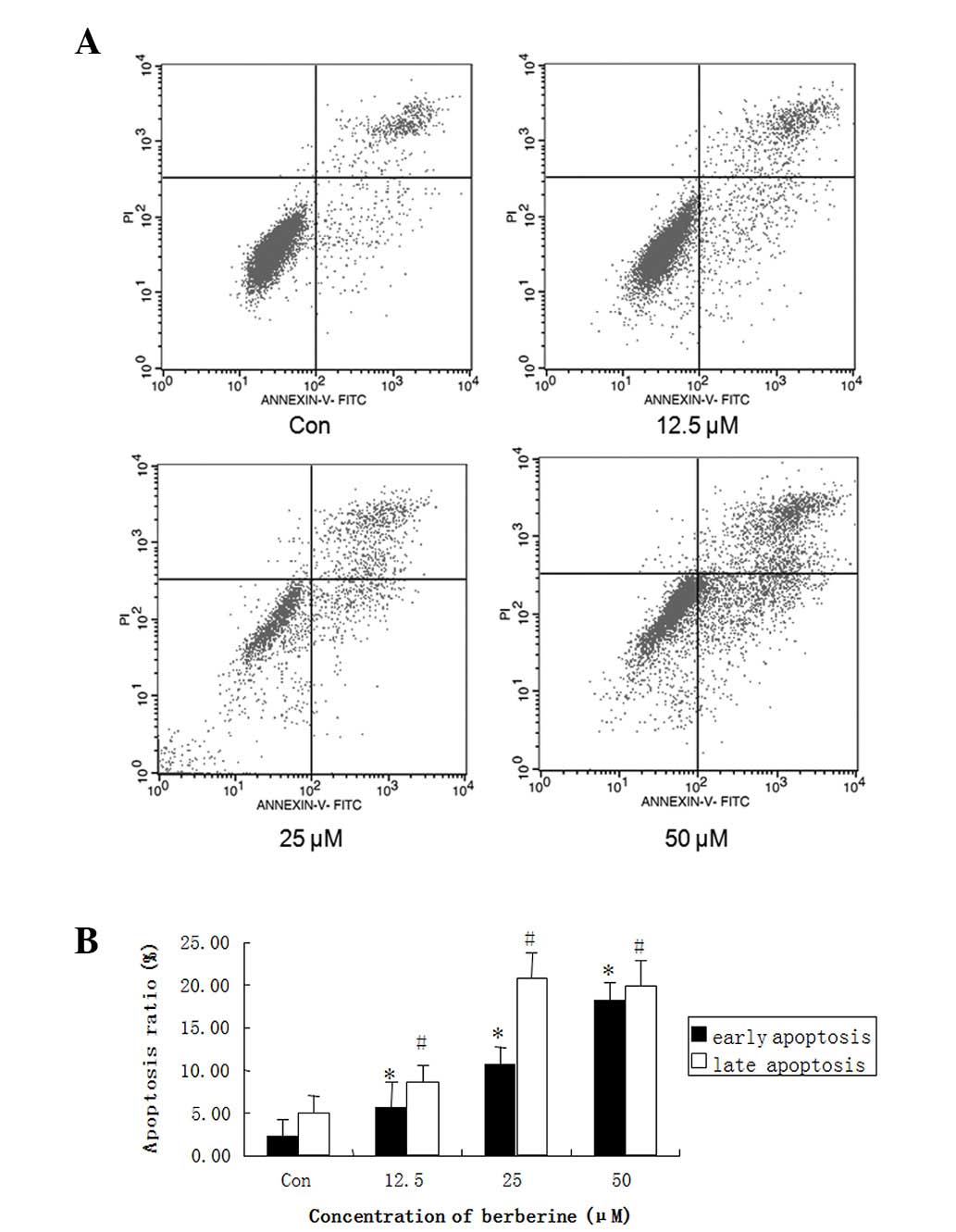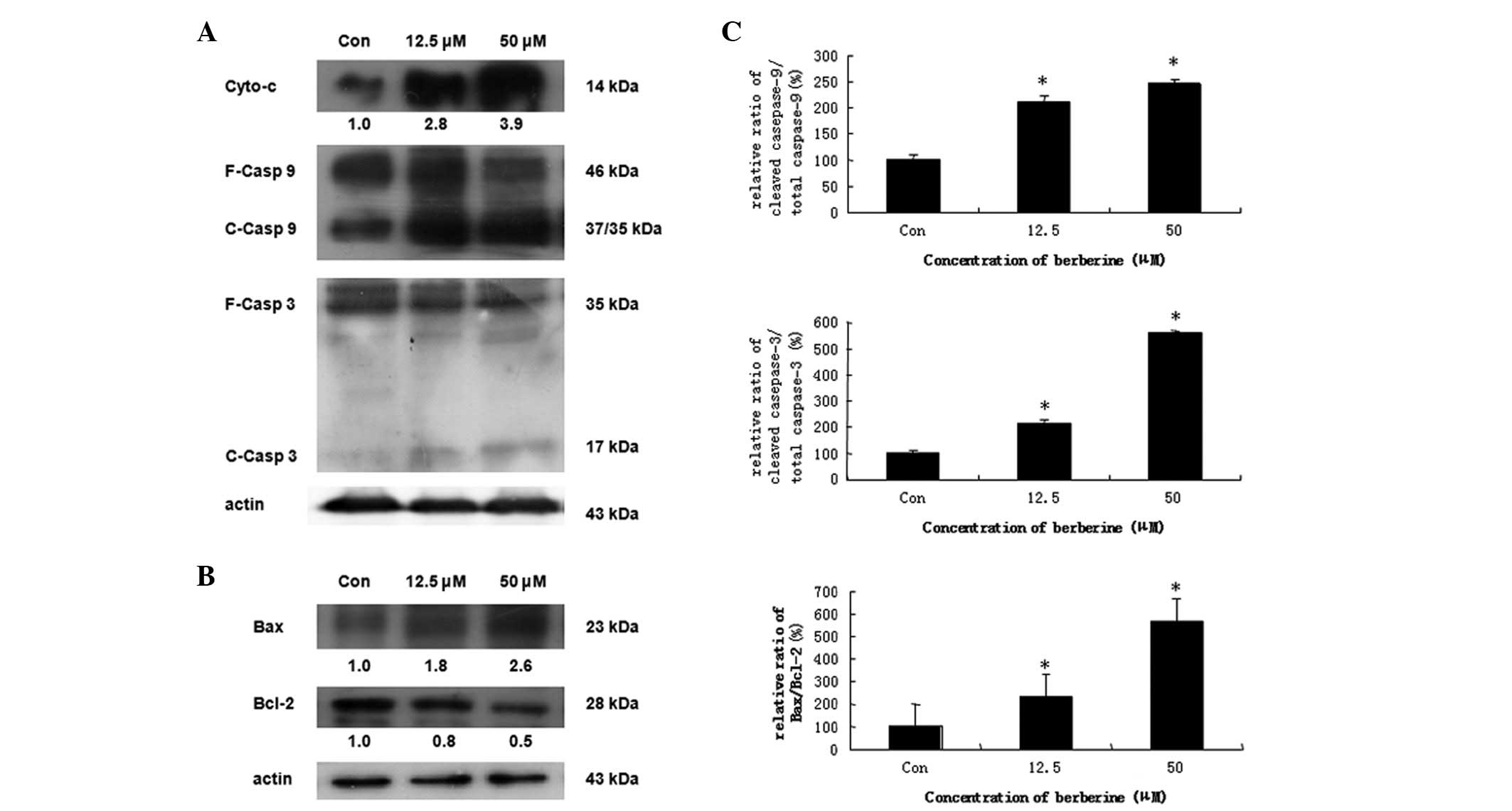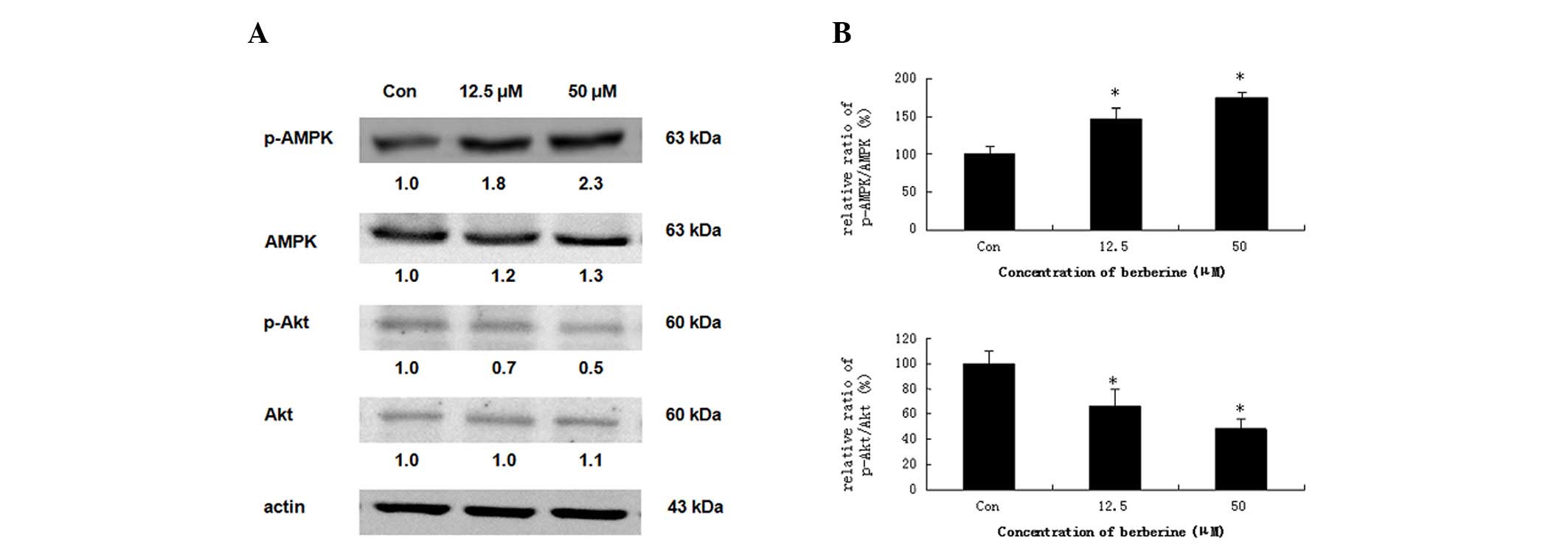Berberine induces selective apoptosis through the AMPK‑mediated mitochondrial/caspase pathway in hepatocellular carcinoma
- Authors:
- Published online on: May 31, 2013 https://doi.org/10.3892/mmr.2013.1506
- Pages: 505-510
Abstract
Introduction
Hepatocellular carcinoma (HCC) is one of the most common and aggressive malignant tumor types worldwide. The incidence of HCC has markedly increased to >600,000 cases annually, and HCC has become the second most common cause of mortality in China (1,2). Numerous risk factors, including chronic infection with hepatitis B and C viruses, alcohol-related cirrhosis and non-alcoholic fatty liver diseases, are closely correlated with the occurrence and development of HCC (3–5). Furthermore, a large percentage of patients with advanced HCC require systemic or selective chemotherapy to achieve a longer life expectancy. Unfortunately, the overall survival rate remains poor with the use of traditional chemotherapy, as HCC is insensitive to conventional cytotoxic agents (6,7). Therefore, there is a significant requirement for the development of innovative treatment approaches to improve patient outcome.
AMP-activated protein kinase (AMPK) is a metabolic sensing protein kinase that acts as an important energy sensor, mainly in ATP-deprived conditions (8). Therefore, AMPK is known to play a major protective role under conditions of metabolic stress. In the activated state, AMPK downregulates several anabolic enzymes and thus turns off ATP-consuming metabolic pathways (9,10). Several studies have observed the strong pro-apoptotic potential of AMPK in activated conditions, including AMPK activator (AICAR)-treated cells or constitutively active AMPK mutants (11). Collectively, these studies highlight the importance of AMPK as a direct therapeutic target in all stages of cancer.
Berberine, an alkaloid purified from the Berberis species (Fig. 1), has been extensively studied and is known to exhibit multiple pharmacological activities, including antiprotozoal, antihypertensive, antibacterial, anti-inflammatory, anticholinergic and anti-arrhythmic effects (12–14). Previous studies have demonstrated that berberine has anticancer activities against several types of cancer, to include liver cancer (15,16). Berberine has been demonstrated to induce apoptosis in numerous cultured cancer cell lines (17,18); however, the molecular mechanisms underlying berberine-induced apoptosis and the pathways involved have not been fully elucidated to date. In the present study, we aimed to investigate the inhibitory effect of berberine on HCC cell lines and determine whether berberine-induced apoptosis was correlated with the AMPK-mediated caspase-dependent mitochondrial pathway.
Materials and methods
Reagents
Berberine (purity, >99%), sulforhodamine B (SRB)and protease inhibitors were purchased from Sigma-Aldrich (St. Louis, MO, USA). The high-glucose medium, Dulbecco’s Modified Eagle’s Medium (DMEM), was obtained from Gibco-BRL (Carlsbad, CA, USA). The Bradford Protein Assay kit, RIPA lysis buffer and the Annexin V-FITC Apoptosis Detection kit were purchased from Beyotime Institute of Biotechnology (Jiangsu, China). Activated signaling pathways were identified using primary antibodies, including anti-AMPK, anti-phosphospecific AMPK, anti-Akt, anti-phosphospecific Akt, anti-Bax, anti-Bcl-2, anti-cytochrome c, anti-caspase-3 and anti-caspase-9, purchased from Santa Cruz Biotechnology, Inc. (Santa Cruz, CA, USA). The internal control antibody (anti-β-actin) was also obtained from Santa Cruz Biotechnology, Inc.
Cell culture
The human hepatocelluar carcinoma cell lines (HepG2, SMMC-7721 and Bel-7402) and the normal liver cell line (HL-7702) were purchased from Hsiang-Ya Medical College (Hunan, China). Cells were cultured at 37°C and 5% CO2 in DMEM supplemented with 10% fetal bovine serum (FBS), penicillin (100 U/ml) and streptomycin (100 mg/ml). The study was approved by the ethics committee of Sichuan University.
Cell treatment and cell viability assay
The in vitro cytotoxicity of berberine against HepG2, SMMC-7721, Bel-7402 and HL-7702 cells was assessed using the traditional SRB assay. The SRB assay is routinely used for cytotoxicity determination, based on the measurement of live cell protein content (19). In brief, cells were seeded into 96-well plates at a density of 7,000 cells/well. Following 24 h of culture in DMEM supplemented with 10% FBS, the medium was replaced with DMEM without FBS for 24 h. Subsequently, the cells were treated with berberine at final concentrations of 3.125, 6.25, 12.5, 25, 50 and 100 μM for 24 or 48 h prior to the SRB assay. All experiments were conducted in parallel with controls; at 24 or 48 h, 100 μl of 10% trichloroacetic acid was also added to each well when staining for 30 min, and then the excess dye was removed by washing repeatedly with 1% acetic acid. The protein-bound dye was dissolved in 10 mM Tris Base solution (Santa Cruz Biotechnology, Inc.) for optical density (OD) determination at 570 nm using a microculture reader (Bio-Rad, Richmond, CA, USA). The percentage of viable cells was calculated as follows: (A of experimental group/A of control group) ×100, where A represents the absorbance.
Apoptosis assays by flow cytometry (FCM)
Apoptosis was analyzed by FCM using the Annexin V-FITC Apoptosis Detection kit (Beyotime Institute of Biotechnology), according to the manufacturer’s instructions. Briefly, following treatment with 0, 12.5, 50 and 100 μM berberine for 24 h, HepG2 cells were detached and resuspended in 100 μl binding buffer containing fluorescein isothiocyanate-conjugated annexin V and propidium iodide (PI). Following incubation for 15 min at room temperature in the dark, the cells were analyzed by FCM (BD Biosciences, Franklin Lakes, NJ, USA).
Western blot assay
The cells were washed twice with cold phosphate-buffered saline (PBS) and then suspended in RIPA buffer for 30 min on ice. The supernatant was collected as the total protein extract. The protein concentration was estimated by the Bradford Protein Assay kit (Beyotime Institute of Biotechnology), according to the manufacturer’s instructions. Equal amounts of protein (40 μg) were analyzed by sodium dodecyl sulphate-polyacrylamide gel electrophoresis (SDS-PAGE) with a 5 or 12% separation gel, and molecular weight markers were run simultaneously. The proteins were transferred to nitrocellulose membranes and then blocked for 2 h at room temperature in a solution of 5% milk or bovine serum albumin (BSA). Incubation with the appropriate primary antibodies was performed overnight at 4°C. Membranes were incubated with horseradish peroxidase (HRP)-conjugated goat anti-rabbit or anti-mouse secondary antibody (1:2,000 dilution) for 2 h at room temperature with gentle agitation. After washing, bands were visualized by an Enhanced Chemiluminescence (ECL) Western Blotting Detection system (Amersham Pharmacia Biotech, NJ, USA).
Statistical analysis
All data were expressed as the mean ± SE. The statistical significance of differences in the data was determined by Student’s t-test. P<0.05 was considered to indicate a statistically significant difference.
Results
Berberine inhibits cell viability in HCC cell lines in a time- and dose-dependent manner
To evaluate the antitumor characteristics of berberine, cell viability was measured by a standard SRB assay following brief exposure to berberine (24 or 48 h). As demonstrated in Fig. 2, berberine significantly reduced cell viability in human hepatoma cell lines in a time- and dose-dependent manner. Subsequently, we predicted the side effects of berberine by exposing the normal hepatic cell line, HL-7702, to the agent. The IC50 values in the HL-7702 cell line (838.4 μM) at 48 h were markedly higher than those of the HCC cell lines (34.5 μM, 25.2 μM and 53.6 μM in the HepG2, SMMC-7721 and Bel-7402 cell lines, respectively). The differences in the IC50 values indicated that berberine was able to selectively decrease the cell viability of HCC cells compared with normal hepatocytes.
Berberine increases apoptosis in HepG2 cells
To further investigate the inhibition mechanism of berberine in HCC, we selected HepG2 cells for further study. HepG2 cells were treated with 12.5, 25 and 50 μM berberine for 24 h, and apoptosis was detected by flow cytometric analysis with the Annexin V-FITC Apoptotic Detection kit (Beyotime Institute of Biotechnology). Data revealed that the pretreatment of HepG2 cells with berberine significantly increased the number of early apoptotic cells (annexin V+ and PI−) and late apoptotic cells (annexin V+ and PI+) compared with the control group, in a dose-dependent manner (Fig. 3A). At a concentration of 50 μM, berberine led to ≤40% apoptosis in HepG2 cells (Fig. 3B). These results suggested that berberine-induced apoptosis in the liver cancer cells contributed to its antiproliferative and cytotoxic effects.
Berberine induces apoptosis via the mitochondrial-dependent pathway
In chemically induced apoptosis, mitochondria play a central role in the commitment of cells to apoptosis through cytochrome c-dependent pathways. To elucidate the molecular mechanism of berberine-induced apoptosis in HCC cells, we examined the expression of proteins associated with apoptosis. HepG2 cells were treated with 12.5 and 50 μM berberine for 24 h. The results demonstrated that creatine kinase induces the release of cytochrome c from mitochondria to the cytosol in dose-dependent manner (data not shown). Caspase-9 and -3, well-known downstream molecules of cytochrome c, were also cleaved in a concentration-dependent manner (Fig. 4A). We further evaluated the effect of berberine on the mitochondrial apoptosis signaling pathway. We found that the expression of Bcl-2 protein, an anti-apoptotic molecule, decreased in a dose-dependent manner, whereas the expression of the pro-apoptotic protein, Bax, was significantly increased (Fig. 4B). Furthermore, the ratio of Bax/Bcl-2 was increased in a dose-dependent manner (Fig. 4C). These results indicated that treatment with berberine leads to a shift from anti-apoptosis to pro-apoptosis by altering the function of the proteins in the Bcl-2 family, which results in the release of cytochrome c from mitochondria, thus inducing caspase-dependent mitochondrial pathway cell apoptosis.
Effects of berberine on the protein expression of AMPK and Akt
Several reports have demonstrated that activation of AMPK leads to the induction of apoptosis in numerous human cancer cell types (20,21). Therefore, we investigated whether the phosphorylation of AMPK is induced by berberine. HepG2 cells were treated with 12.5 and 50 μM berberine for 24 h. As demonstrated in Fig. 5A, compared with the basal level, berberine significantly stimulated the phosphorylation of AMPK (Thr-172), which increased the ratio of p-AMPK/total-AMPK in dose-dependent manner. The measurements of the phosphorylation pattern of Akt revealed that the pretreatment of HepG2 cells with berberine resulted in a marked elevation in the levels of phosphorylated Akt (Ser-473) relative to the control cells, without significantly altering the total protein levels of Akt (Fig. 5B). These results indicated that AMPK activation is correlated with the induction of apoptosis.
Discussion
HCC has a higher prevalence and mortality rate compared with other types of cancer. Therefore, prolonging survival times and improving quality of life have become main objectives in the treatment and management of patients with advanced HCC. The antitumor property of berberine has recently attracted increasing research attention (22). A crucial advantage for the use of natural products as an alternative to the chemotherapeutic approach is their low cytotoxicity. In the present study, we examined the effect of berberine on cell viability and apoptosis in normal and cancer cells. We observed that berberine suppressed cell growth in a dose- and time-dependent manner in human HepG2, SMMC-7721 and Bel-7404 HCC cell lines. This indicates that the inhibitory effect of berberine in liver cancer is non-species-specific, and is associated with the previously reported types of HCC cells (23). The normal control liver cell line, HL-7702, exhibited decreased cell viability.
Berberine is one of the key components of Coptis chinesis, which is frequently utilized in proprietary Chinese herbal drugs and exerts a wide range of pharmacological effects. Berberine exhibits high antitumor activity in various types of tumors through different mechanisms (16,17,24). A number of factors, including cytokines, chemokines, receptors and downstream elements within signaling cascade pathways, are correlated with apoptosis induced by berberine. Berberine has been demonstrated to induce apoptosis in human HCC cells via Fas-mediated (15) inhibition of the mTOR-signaling pathway (16), downregulation of MMP-9 expression (25) and the nuclear factor-κB (NF-κB) and activator protein 1 (AP-1) pathways (26). In the current study, we demonstrated that berberine had cytotoxic effects in HepG2 cells, including annexin V binding, cytochrome c release and activation of caspases, indicated by the increased cleavage of caspase-9 and -3, via caspase-dependent mitochondrial pathway cell apoptosis.
The association between cancer and AMPK emerges as an intriguing area of investigation. Numerous studies have indicated that the AMPK pathway is implicated in cancer. While traditionally regarded as a sensor of cellular energy status and a regulator of metabolism, AMPK has been linked to tumor suppressors, including LKB1, p53, TSC1 and TSC2, providing novel support for the theory that AMPK may function as a suppressor of cell proliferation (27). There has been much speculation on the role of AMPK in cancer, as this pathway may be either anti-apoptotic or pro-apoptotic depending on the conditions (28). The results of the present study demonstrated that treatment with berberine promoted AMPK phosphorylation and inhibited Akt phosphorylation in HepG2 cells, which led to caspase-dependent mitochondrial pathway cell apoptosis.
In conclusion, to the best of our knowledge, our results demonstrate for the first time that berberine exerts a selective antitumor effect on human liver cancer cells when compared with non-tumorigenic HL-7702 normal liver cells. Additionally, our data provide support to the theory that AMPK may be involved in the antitumor effect of berberine via caspase-dependent mitochondrial pathway cell apoptosis. These findings provide a molecular basis for the antiproliferative activity of berberine, which may be used as a potent and alternative chemotherapeutic agent for the treatment of HCC.
Acknowledgements
This study was supported by the China National Nature Science Fund (no. 30671963), the China Medical Board of New York Inc. (no. 98-681) and the Sichuan University 985 project (Science and Technology Innovation Platform for Novel Drug Development).
References
|
Parkin DM, Bray F, Ferlay J and Pisani P: Global cancer statistics, 2002. CA Cancer J Clin. 55:74–108. 2005. View Article : Google Scholar | |
|
Tang ZY, Ye SL, Liu YK, et al: A decade’s studies on metastasis of hepatocellular carcinoma. J Cancer Res Clin Oncol. 130:187–196. 2004. | |
|
Ming L, Thorgeirsson SS, Gail MH, et al: Dominant role of hepatitis B virus and cofactor role of aflatoxin in hepatocarcinogenesis in Qidong, China. Hepatology. 36:1214–1220. 2002. View Article : Google Scholar : PubMed/NCBI | |
|
El-Serag HB: Epidemiology of hepatocellular carcinoma in USA. Hepatol Res. 37(Suppl 2): S88–S94. 2007. View Article : Google Scholar : PubMed/NCBI | |
|
Parkin DM: The global health burden of infection-associated cancers in the year 2002. Int J Cancer. 118:3030–3044. 2006.PubMed/NCBI | |
|
Petraccia L, Onori P, Sferra R, et al: MDR (multidrug resistance) in hepatocarcinoma clinical-therapeutic implications. Clin Ter. 154:325–335. 2003.(In Italian). | |
|
Zhang C, Liu L, Yu Y, Chen B, Tang C and Li X: Antitumor effects of ginsenoside Rg3 on human hepatocellular carcinoma cells. Mol Med Rep. 5:1295–1298. 2012.PubMed/NCBI | |
|
Hardie DG, Carling D and Carlson M: The AMP-activated/SNF1 protein kinase subfamily: metabolic sensors of the eukaryotic cell. Annu Rev Biochem. 67:821–855. 1998. View Article : Google Scholar : PubMed/NCBI | |
|
Hardie DG: Minireview: the AMP-activated protein kinase cascade: the key sensor of cellular energy status. Endocrinology. 144:5179–5183. 2003. View Article : Google Scholar : PubMed/NCBI | |
|
Hardie DG and Sakamoto K: AMPK: a key sensor of fuel and energy status in skeletal muscle. Physiology. 21:48–60. 2006. View Article : Google Scholar : PubMed/NCBI | |
|
Garcia-Gil M, Pesi R, Perna S, et al: 5′-Aminoimidazole-4-carboxamide riboside induces apoptosis in human neuroblastoma cells. Neuroscience. 117:811–820. 2003. | |
|
Akhter MH, Sabir M and Bhide NK: Anti-inflammatory effect of berberine in rats injected locally with cholera toxin. Indian J Med Res. 65:133–141. 1977.PubMed/NCBI | |
|
Hwang JM, Wang CJ, Chou FP, Tseng TH, Hsieh YS, Lin WL and Chu CY: Inhibitory effect of berberine on tert-butyl hydroperoxide-induced oxidative damage in rat liver. Arch Toxicol. 76:664–670. 2002. View Article : Google Scholar : PubMed/NCBI | |
|
Tsai CS and Ochillo RF: Pharmacological effects of berberine on the longitudinal muscle of the guinea-pig isolated ileum. Arch Int Pharmacodyn Ther. 310:116–131. 1991.PubMed/NCBI | |
|
Wang GY, Lv QH, Dong Q, Xu RZ and Dong QH: Berbamine induces Fas-mediated apoptosis in human hepatocellular carcinoma HepG2 cells and inhibits its tumor growth in nude mice. J Asian Nat Prod Res. 11:219–228. 2009. View Article : Google Scholar : PubMed/NCBI | |
|
Wang N, Feng Y, Zhu M, et al: Berberine induces autophagic cell death and mitochondrial apoptosis in liver cancer cells: the cellular mechanism. J Cell Biochem. 111:1426–1436. 2010. View Article : Google Scholar : PubMed/NCBI | |
|
Patil JB, Kim J and Jayaprakasha GK: Berberine induces apoptosis in breast cancer cells (MCF-7) through mitochondrial-dependent pathway. Eur J Pharmacol. 645:70–78. 2010. View Article : Google Scholar : PubMed/NCBI | |
|
Ho YT, Lu CC, Yang JS, et al: Berberine induced apoptosis via promoting the expression of caspase-8, -9 and -3, apoptosis-inducing factor and endonuclease G in SCC-4 human tongue squamous carcinoma cancer cells. Anticancer Res. 29:4063–4070. 2009. | |
|
Vichai V and Kirtikara K: Sulforhodamine B colorimetric assay for cytotoxicity screening. Nat Protoc. 1:1112–1116. 2006. View Article : Google Scholar : PubMed/NCBI | |
|
Kim YM, Hwang JT, Kwak DW, et al: Involvement of AMPK signaling cascade in capsaicin-induced apoptosis of HT-29 colon cancer cells. Ann N Y Acad Sci. 1095:496–503. 2007. View Article : Google Scholar : PubMed/NCBI | |
|
Ji CB, Yang B, Yang YL, et al: Exogenous cell-permeable C6 ceramide sensitizes multiple cancer cell lines to Doxorubicin-induced apoptosis by promoting AMPK activation and mTORC1 inhibition. Oncogene. 29:6557–6568. 2010. View Article : Google Scholar : PubMed/NCBI | |
|
Dorai T and Aggarwal BB: Role of chemopreventive agents in cancer therapy. Cancer Lett. 5:129–140. 2004. View Article : Google Scholar | |
|
Hwang JM, Kuo HC, Tseng TH, Liu JY and Chu CY: Berberine induces apoptosis through a mitochondria/caspases pathway in human hepatoma cells. Arch Toxicol. 80:62–73. 2006. View Article : Google Scholar : PubMed/NCBI | |
|
Hur JM, Hyun MS, Lim SY, Lee WY and Kim D: The combination of berberine and irradiation enhances anti-cancer effects via activation of p38 MAPK pathway and ROS generation in human hepatoma cells. J Cell Biochem. 107:955–964. 2009. View Article : Google Scholar : PubMed/NCBI | |
|
Liu B, Wang G, Yang J, Pan X, Yang Z and Zang L: Berberine inhibits human hepatoma cell invasion without cytotoxicity in healthy hepatocytes. PLoS One. 6:e214162011. View Article : Google Scholar : PubMed/NCBI | |
|
Chao DC, Lin LJ, Kao ST, et al: Inhibitory effects of Zuo-Jin-Wan and its alkaloidal ingredients on activator protein 1, nuclear factor-κB, and cellular transformation in HepG2 cells. Fitoterapia. 82:696–703. 2011.PubMed/NCBI | |
|
Motoshima H, Goldstein BJ, Igata M and Araki E: AMPK and cell proliferation - AMPK as a therapeutic target for atherosclerosis and cancer. J Physiol. 574:63–71. 2006. View Article : Google Scholar : PubMed/NCBI | |
|
Luo Z, Saha AK, Xiang X and Ruderman NB: AMPK, the metabolic syndrome and cancer. Trends Pharmacol Sci. 26:69–76. 2005. View Article : Google Scholar : PubMed/NCBI |



